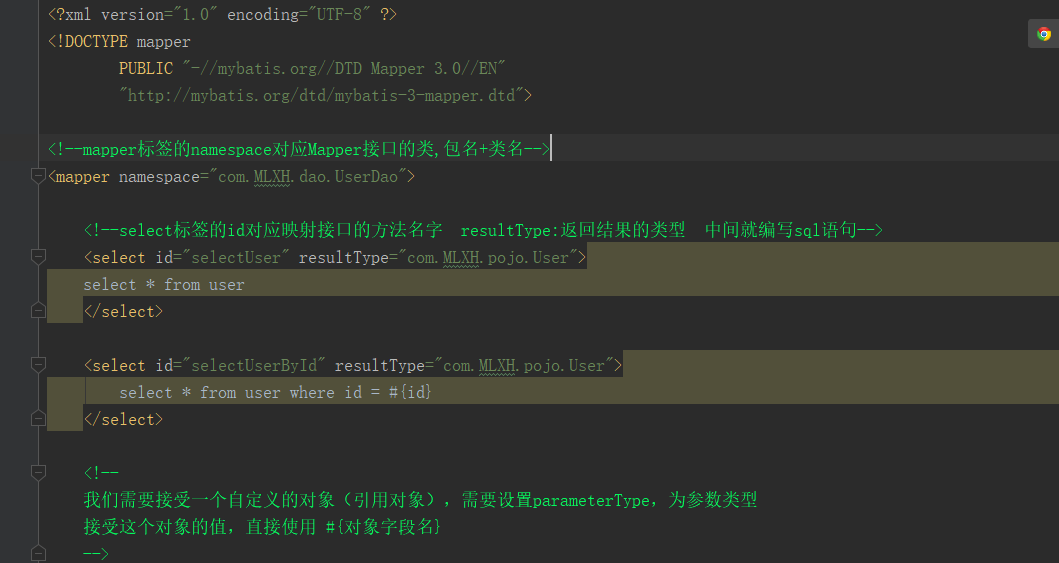更新时间:2021-12-20 09:46:47 来源:赢咖4 浏览575次
sql的分页语句为(第一个参数是当前页面的索引起始位置,第二个参数是显示的页数)
select * from user limit #{startIndex},#{pageSize};
# startIndex: 起始位置,默认为 0
# pageSize: 页面大小
# 如何计算当前页面索引的起始位置
# currentPage = (currentPage-1)* pageSize
编写dao接口
//查询所有用户实现分页
List < User > selectUserByLimit ( Map < String , Integer > map ) ;
编译mapper映射文件的方法(可以通过map封装参数,方便参数传递)
< select id = " selectUserByLimit " parameterType = " Map " resultType = " User " >
select * from mybatis.user limit #{startIndex},#{pageSize}
</选择>
创建了用于获取 sqlSession 对象的工具类,并使自动提交事务成为可能。
包装融为一体。MLXH 。实用程序;
进口组织。阿帕奇。伊比斯。约。资源;
进口组织。阿帕奇。伊比斯。会话。SqlSession ;
进口组织。阿帕奇。伊比斯。会话。SqlSessionFactory ;
进口组织。阿帕奇。伊比斯。会话。SqlSessionFactoryBuilder ;
导入java 。约。IO异常;
导入java 。约。输入流;
//mybatis工具类,重复代码的净化
public class MyBatisUtils {
//类变量不需要设置默认值;
私有 静态SqlSessionFactory sqlSessionFactory ;
static {
//在maven中,所有的资源文件一般都放在resources目录下,我们可以直接获取。
尝试 {
字符串资源= "mybatis-config.xml" ;
InputStream inputStream =资源。getResourceAsStream (资源);
sqlSessionFactory = new SqlSessionFactoryBuilder ( ) 。构建(的inputStream );
} catch ( IOException e ) {
e. 打印堆栈跟踪();
}
}
//设置SqlSessionFactory的方法 public
public static SqlSessionFactory getSqlSessionFactory ( ) {
return sqlSessionFactory ;
}
//带有事务自动提交功能的通用SqlSession方法
public static SqlSession getSqlSession ( ) {
//自动提交事务
return sqlSessionFactory . openSession (真) ;
}
}
测试(模拟分页数据参数:当前Page,page Size)
@Test
public void selectUserByLimit ( ) {
//创建sqlSession
SqlSessionFactory sqlSessionFactory = MyBatisUtils . getSqlSessionFactory ( ) ;
SqlSession sqlSession = sqlSessionFactory 。openSession ( ) ;
//准备数据
int currentPage = 2 ; //当前页面是什么?
int pageSize = 2 ; //页面大小
Map < String , Integer > map = new HashMap < String , Integer > ( ) ;
地图。put ( "startIndex" , ( currentPage - 1 ) * pageSize ) ;
地图。put ( "pageSize" , pageSize ) ;
//测试
UserDao 映射器= sqlSession . getMapper ( userDAO的。类);
列表<用户>用户=映射器。selectUserByLimit (地图) ;
for (用户用户:用户) {
系统。出来。打印(用户);
}
sqlSession 。关闭( ) ; //关闭连接
}
1.写接口
//查询所有用户使用RowBounds
List < User > selectUserByRowBounds ( )实现分页;
2.编写Mapper映射文件
< select id = " selectUserByRowBounds " resultType = " User " >
从 mybatis.user 中选择 *
</选择>
3.工具类同上(只是获取sqlSession对象很简单)
4.编写测试代码
@Test
public void selectUserByRowBounds ( ) {
//创建sqlSession
SqlSessionFactory sqlSessionFactory = MyBatisUtils . getSqlSessionFactory ( ) ;
SqlSession sqlSession = sqlSessionFactory 。openSession ( ) ;
int currentPage = 2 ; //当前页面
int pageSize = 2 ; //页面大小
RowBounds rowBounds = new RowBounds ( ( currentPage - 1 ) * pageSize , pageSize ) ;
//注意getMapper不能和RowBounds
一起
使用//selectList: Receive a List //Select Map: Receive a Map
//selectOne: 当只接收一个对象
List < User > users = sqlSession . selectList ( "com.MLXH.dao.UserDao.selectUserByRowBounds" , null , rowBounds ) ;
for (用户用户:用户) {
系统。出来。打印(用户);
}
}
rowBounds 的本质是封装limit。
limit在SQL层面实现分页,使用getMapper获取测试中的对象
RowBounds 在代码层面实现分页,创建 rowBounds 对象
增删改查示例(详细代码和目录布局)可以看到对于UserDao接口,我们需要创建一个userMapper.xml来实现该接口并在其中写入sql语句。

接下来,我们使用注解来简化它们的代码操作。
包装融为一体。MLXH 。道;
进口玉米。MLXH 。波乔。用户;
进口组织。阿帕奇。伊比斯。注释。* ;
导入java 。UTIL 。列表;
公共 接口 UserDao {
//查询所有用户
@Select ( "select * from user" )
List < User > getUserList ( ) ;
//通过ID查询用户
@Select ( "select * from user where id = #{id}" )
User getUserById ( @Param ( "id" ) int id ) ;
//添加用户
@Insert ( "insert into user(id,name,pwd) values (#{id},#{name},#{pwd})" )
int addUser ( User user ) ;
//修改用户信息
@Update ( "update user set name = #{name}, pwd = #{pwd} where id = #{id}" )
int updateUser ( User user ) ;
//删除用户
@Delete ( "delete from user where id =#{uid}" )
int deleteUser ( @Param ( "uid" ) int id ) ;
}
用户道
包装融为一体。MLXH 。道;
进口玉米。MLXH 。波乔。用户;
进口组织。阿帕奇。伊比斯。注释。* ;
导入java 。UTIL 。列表;
公共 接口 UserDao {
//查询所有用户
@Select ( "select * from user" )
List < User > getUserList ( ) ;
//通过ID查询用户
@Select ( "select * from user where id = #{id}" )
User getUserById ( @Param ( "id" ) int id ) ;
//添加用户
@Insert ( "insert into user(id,name,pwd) values (#{id},#{name},#{pwd})" )
int addUser ( User user ) ;
//修改用户信息
@Update ( "update user set name = #{name}, pwd = #{pwd} where id = #{id}" )
int updateUser ( User user ) ;
//删除用户
@Delete ( "delete from user where id =#{uid}" )
int deleteUser ( @Param ( "uid" ) int id ) ;
}
@Param 是一个参数注解。输入参数为1时,默认为Param,但输入参数多于1时,在每个参数前加上@Param,标识为参数。
例如: int update(@Param("id") int id,@Param("name") String name,@Param("pwd") String pwd)
Mybatis 核心简介
<?xml version="1.0" encoding="UTF-8" ?>
<!DOCTYPE 配置
PUBLIC "-//mybatis.org//DTD Config 3.0//EN"
《http://mybatis.org/dtd/mybatis-3-config.dtd">
<配置>
<!--配置文件修改-->
< properties resource = " database.properties " />
<!--Mybatis 设置-->
< settings >
<!--默认日志实现-->
<!--<setting name="logImpl" value="STDOUT_LOGGING"/>-->
<!--Log4j实现-->
<设置 名称= " logImpl " 值= " LOG4J " />
</设置>
<!--配置别名-->
< typeAliases >
<!--<typeAlias type="com.MLXH.pojo.User" alias="User"/>-->
<包 名= " com.MLXH.pojo " />
</ 类型别名>
<环境 默认= “开发” >
<环境 id = “开发” >
<事务管理器 类型= “ JDBC ” />
<数据源 类型= “ POOLED ” >
<属性 名称= “驱动程序” 值= “ ${driver} ” />
<属性 名称= " url " value = " ${url} " />
< property name = " username " value = " ${username} " />
< property name = " password " value = " ${password} " />
</ dataSource >
</环境>
</环境>
< mappers >
<!--class 对应一个接口类-->
<!--resource 一个接口类对应的映射文件-->
< mapper class = " com.MLXH.dao.UserDao " />
</ mappers >
</配置>
这里我们将sqlSession对象的创建封装为一个工具方法,设置事务自动提交(sqlSession Factory.openSession(true))
工具类
包装融为一体。MLXH 。实用程序;
进口组织。阿帕奇。伊比斯。约。资源;
进口组织。阿帕奇。伊比斯。会话。SqlSession ;
进口组织。阿帕奇。伊比斯。会话。SqlSessionFactory ;
进口组织。阿帕奇。伊比斯。会话。SqlSessionFactoryBuilder ;
导入java 。约。IO异常;
导入java 。约。输入流;
//mybatis工具类,重复代码的净化
public class MyBatisUtils {
//类变量不需要设置默认值;
私有 静态SqlSessionFactory sqlSessionFactory ;
static {
//在maven中,所有的资源文件一般都放在resources目录下,我们可以直接获取。
尝试 {
字符串资源= "mybatis-config.xml" ;
InputStream inputStream =资源。getResourceAsStream (资源);
sqlSessionFactory = new SqlSessionFactoryBuilder ( ) 。构建(的inputStream );
} catch ( IOException e ) {
e . 打印堆栈跟踪();
}
}
//设置SqlSessionFactory的方法 public
public static SqlSessionFactory getSqlSessionFactory ( ) {
return sqlSessionFactory ;
}
//带有事务自动提交功能的通用SqlSession方法
public static SqlSession getSqlSession ( ) {
//自动提交事务
return sqlSessionFactory . openSession (真) ;
}
}
测试
包装融为一体。MLXH 。道;
进口玉米。MLXH 。波乔。用户;
进口玉米。MLXH 。实用程序。MyBatisUtils ;
进口组织。阿帕奇。伊比斯。会话。SqlSession ;
进口组织。JUnit的。测试;
进口太阳。rmi . 服务器。单播服务器引用;
导入java 。UTIL 。列表;
公共 类 UserDaoTest {
@Test
public void getUserList ( ) {
SqlSession sqlSession = MyBatisUtils . getSqlSession ( ) ; //带自动提交事务
UserDao mapper = sqlSession . getMapper ( userDAO的。类);
列表<用户> userList = mapper 。获取用户列表( ) ;
对于 (用户用户: userList ) {
系统。出来。打印(用户);
}
SQLSESSION 。关闭( ) ; //关闭sqlSession;
}
@Test
public void getUserById ( ) {
SqlSession sqlSession = MyBatisUtils . getSqlSession ( ) ; //带自动提交事务
UserDao mapper = sqlSession . getMapper ( userDAO的。类);
用户 user = mapper 。getUserById ( 1 ) ;
系统。出来。打印(用户);
sqlSession 。关闭( ) ; //关闭sqlSession;
}
@Test
public void addUser ( ) {
SqlSession sqlSession = MyBatisUtils . getSqlSession ( ) ; //带自动提交事务
UserDao mapper = sqlSession . getMapper ( userDAO的。类);
用户用户= 新 用户(5 , “冷雪” , “寒雪” );
int i =映射器。添加用户(用户);
系统。出来。打印(我);
sqlSession 。关闭( ) ; //关闭sqlSession;
}
@Test
public void updateUser ( ) {
SqlSession sqlSession = MyBatisUtils . getSqlSession ( ) ; //带自动提交事务
UserDao mapper = sqlSession . getMapper ( userDAO的。类);
User user = new User ( 5 , "暮光之城" , "木灵寒雪" ) ;
int i =映射器。更新用户(用户);
系统。出来。打印(我);
sqlSession 。关闭( ) ; //关闭sqlSession;
}
@Test
public void deleteUser ( ) {
SqlSession sqlSession = MyBatisUtils . getSqlSession ( ) ; //带自动提交事务
UserDao mapper = sqlSession . getMapper ( userDAO的。类);
int i =映射器。删除用户(5 );
系统。出来。打印(我);
sqlSession 。关闭( ) ; //关闭sqlSession;
}
}
总结:如你所见,注解开发其实就是封装接口的mapper文件,在接口方法中加入sql语句。如果您对此比较感兴趣,想了解更多相关知识,可以关注一下赢咖4的MyBatis视频教程,教程内容通俗易懂,适合没有基础的小伙伴学习,希望对大家能够有所帮助。
 Java实验班
Java实验班
0基础 0学费 15天面授
 Java就业班
Java就业班
有基础 直达就业
 Java夜校直播班
Java夜校直播班
业余时间 高薪转行
 Java在职加薪班
Java在职加薪班
工作1~3年,加薪神器
 Java架构师班
Java架构师班
工作3~5年,晋升架构
提交申请后,顾问老师会电话与您沟通安排学习